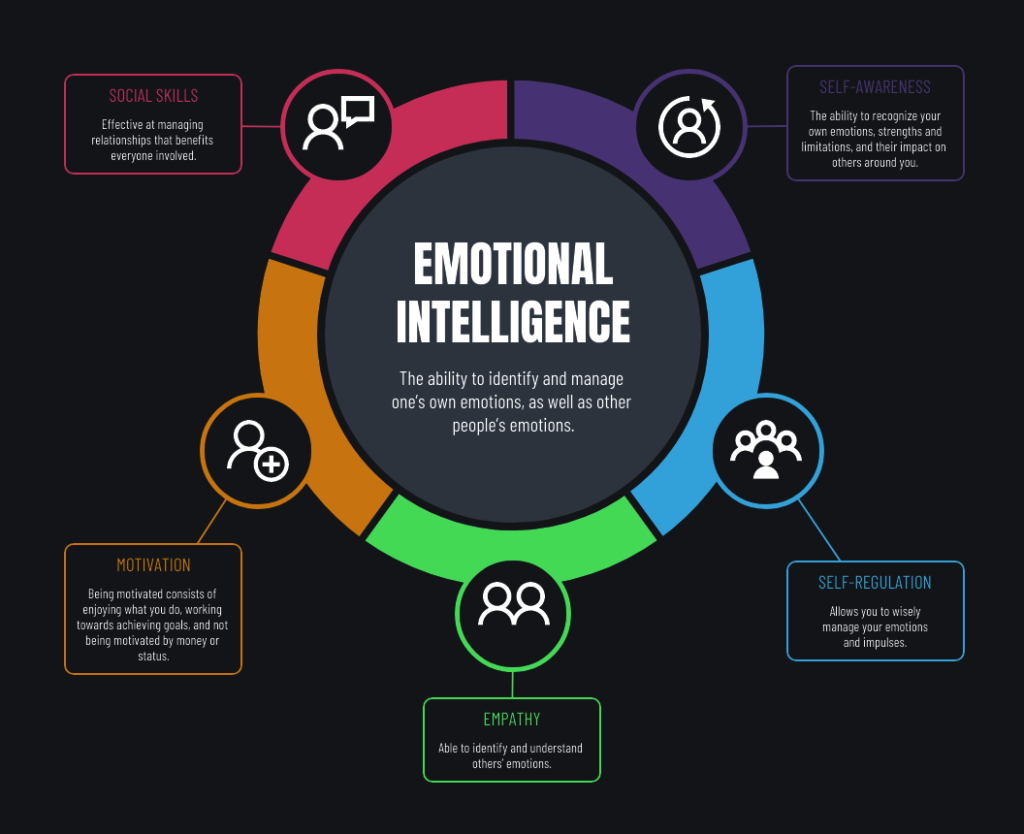5-Minute Guide: Daniel Goleman’s Take on Emotional Intelligence
In the symphony of life, emotional intelligence is the conductor, guiding us through the intricate melodies of human connection, self-awareness, and success.

In the symphony of life, emotional intelligence is the conductor, guiding us through the intricate melodies of human connection, self-awareness, and success.
Join us on an illuminating expedition through the pages of Daniel Goleman’s groundbreaking book, “Emotional Intelligence,” as we unravel the significance of this often overlooked yet crucial aspect of our lives.
Table of Contents
Harmony in Understanding Emotions
Goleman’s exploration begins in the first section, “The Emotional Brain,” where he introduces us to the concept of emotions as the very essence of our humanity. Imagine a scenario: a colleague criticizes your work.
The emotional brain responds instantaneously, triggering feelings of frustration, self-doubt, or even anger.
Goleman takes us through the neural pathways that shape these emotions, explaining how they influence our thoughts and behaviors.
Consider the example of a challenging decision at work. Goleman’s insights shed light on how the limbic system, including the hippocampus, thalamus, and hypothalamus, collaborates to process emotions. This understanding becomes a compass, helping us navigate through the intricate landscape of our reactions.
Fear’s Intricate Dance: The Amygdala Unveiled
Goleman’s discussion on the amygdala in “The Emotional Brain” opens a window into the realm of fear responses. Picture a situation where fear arises – perhaps a public speaking engagement.
The amygdala, that small almond-shaped structure, orchestrates the fear response. Goleman’s narrative provides clarity on why such emotional reactions occur and how they sometimes lead to irrational behavior.
Prefrontal Symphony: The Conductor of Emotional Regulation

As we delve into “The Prefrontal Cortex and Its Role in Emotional Regulation,” consider the prefrontal cortex as the maestro, regulating the emotional symphony. This section provides a lens through which we can view the modulation of emotional responses.
Think of it as the calming influence during a heated discussion, allowing rational decision-making to prevail.
Practical Insights for Everyday Decision-Making
Goleman’s emphasis on the importance of understanding emotions for effective decision-making becomes tangible in scenarios we encounter daily. Imagine a moment of disagreement in a team meeting.
Emotional intelligence, as articulated by Goleman, encourages us to be aware of our emotions and regulate them, transforming potential conflict into constructive dialogue.
Embracing Emotional Intelligence: From Definition to Application
Moving into the heart of the book, “The Nature of Emotional Intelligence,” Goleman defines emotional intelligence as the capacity to recognize and manage our own feelings and those of others.
Let’s bring this definition to life with an example: Imagine a leader who, through self-awareness, acknowledges and regulates their stress during a challenging project. This leader, armed with emotional intelligence, fosters a positive and productive work environment.
Success Symphony: Emotional Intelligence in Personal and Professional Arenas
In “The Importance of Emotional Intelligence in Personal and Professional Success,” Goleman presents research showcasing emotional intelligence as a superior predictor of success compared to IQ.
Consider the contrasting scenarios of two colleagues – one excelling not just due to technical skills but also because of their ability to understand and manage emotions effectively.
A Lifelong Learning Journey
Addressing the common doubt of whether emotional intelligence can be developed, Goleman’s “How Emotional Intelligence Differs from IQ” section becomes a beacon of hope.
Imagine a student who, through self-reflection and emotional intelligence training, transforms their ability to manage stress during exams, leading to improved academic performance.
Real-world Applications: From Relationships to Resilience
“Emotional Intelligence Applied” takes us from theory to practice. Imagine a couple navigating a disagreement. Through empathy, communication, and conflict resolution – components of emotional intelligence – they transform conflict into understanding, fortifying their relationship.
Consider a workplace scenario: A leader with high emotional intelligence inspires and motivates their team effectively. This leader, through social awareness and relationship management, becomes the catalyst for a harmonious and productive work environment.
Windows of Opportunity: A Lifelong Symphony
In “Windows of Opportunity,” Goleman speaks of critical periods in our lives for developing emotional intelligence.
Imagine a child learning to navigate their emotions with guidance from emotionally intelligent parents. This early cultivation becomes a foundation for a resilient and emotionally aware individual.
Common Questions Unveiled
Goleman anticipates and addresses common questions readers may have about emotional intelligence. The importance of emotional intelligence becomes vividly apparent when we consider its role in enhancing relationships, improving well-being, and navigating life’s challenges effectively.
The Heart of “Emotional Intelligence”: A Transformative Guide
In conclusion, “Emotional Intelligence” by Daniel Goleman serves not only as a guide but as a transformative companion in our quest for personal and professional growth. Each page resonates with real-world examples, inviting readers to introspect and apply these insights to their own lives.
As you embark on this transformative journey through “Emotional Intelligence,” consider sharing your thoughts and experiences. Let us together amplify the symphony of emotional intelligence, fostering understanding, empathy, and success in our lives.

5 Essential Networking Tips for Introverts in 2024 (Without the Awkwardness)

Networking can sometimes feel like stepping into a room full of strangers with no idea what to say. For introverts, it’s even tougher.
But guess what? Networking doesn’t have to feel like a chore.
In fact, it can be easier and even enjoyable when you use the right strategies.
These networking tips for introverts will help you make real connections without all the small talk. Whether you’re prepping for virtual events or in-person meetups in 2024, this guide has got you covered.
Let’s jump into five simple ways to make networking work for you!
Table of Contents
Why Networking is Crucial, Even for Introverts
You might be thinking, “Do I really need to network?” The short answer is: yes! Even for introverts, networking opens doors you never knew existed. In 2024, with hybrid work setups and virtual connections on the rise, knowing how to build relationships is more important than ever.
Take a cue from Bill Gates or J.K. Rowling—both introverts who found ways to connect deeply with the right people. Bill Gates is known for having thoughtful, impactful conversations. Rowling? She built tight-knit connections, not by mingling in large crowds, but by focusing on a few key people.
Networking doesn’t mean you have to chat with everyone in the room.
It’s about building meaningful relationships in a way that feels comfortable to you. That’s why these networking tips for introverts are perfect for starting strong.
5 Essential Networking Tips for Introverts in 2024
1. Start Small with One-on-One Connections
Walking into a crowded room full of people isn’t your style, and that’s totally fine. Start small by focusing on one-on-one conversations. Tim Ferriss, a fellow introvert, thrives by having deep, personal chats rather than trying to work the room.
Find someone you connect with and have a meaningful conversation. One solid connection beats five awkward small talks any day!
2. Leverage Online Platforms for Networking
Good news for introverts: you don’t have to leave your home to network! Platforms like LinkedIn allow you to network from the comfort of your own space. You can take your time crafting thoughtful messages and even build a network without ever having to shake hands.
This is a great way to grow your network slowly, without the pressure of in-person interactions.
3. Prepare Talking Points in Advance
Walking into a room (or even a virtual meeting) without anything prepared can feel like a nightmare. Don’t worry—there’s an easy fix! Just have a few go-to topics ready. It’s like a safety net for when the conversation gets stuck.
Think of a couple of icebreakers or interesting facts about yourself. It could be as simple as, “Have you read anything interesting lately?” Preparation turns that awkward silence into an easy exchange.
4. Focus on Quality Over Quantity
Networking isn’t about meeting as many people as possible. It’s about making genuine connections. J.K. Rowling focused on building close relationships with a few key people, and it worked wonders for her.
It’s better to walk away with two strong connections than a dozen business cards from people you barely know.
Quality always wins.
5. Practice Active Listening and Ask Thoughtful Questions
Here’s a secret: introverts are natural listeners. Use that to your advantage. Instead of worrying about what to say, focus on what the other person is saying. Ask thoughtful questions, and you’ll be remembered as someone who genuinely cares.
This takes the pressure off you and makes the conversation flow naturally.
How to Build Confidence in Networking as an Introvert
Let’s be real—confidence doesn’t just happen overnight. It builds up, one small win at a time. Start by practicing in low-pressure situations, like virtual events or small group meetups. Imagine Shy Steve at his first networking event. He thought he’d be a nervous wreck, but after just a few conversations, he realized it wasn’t as scary as he imagined.
The more you practice, the better you’ll get. Start slow, and before you know it, you’ll be confidently introducing yourself like a pro.
Remember, it’s not about being perfect—it’s about being present.
Recommended Resources for Networking Success
Looking for more help? Here are some great resources designed specifically for introverts who want to excel at networking.
1. Quiet: The Power of Introverts in a World That Can’t Stop Talking by Susan Cain
- This book dives into the strengths introverts bring to the table and how to harness them in a world that seems made for extroverts.
2. The Introvert’s Edge by Matthew Pollard
- Matthew Pollard shows how introverts can turn networking into a comfortable and effective process. If networking makes you nervous, this book is your go-to guide.
3. LinkedIn
- Yes, it’s a platform, not a book, but LinkedIn is a treasure trove for introverts. You can build professional relationships at your own pace, from anywhere. Plus, you don’t have to worry about face-to-face pressure!
Conclusion and Call to Action
Networking doesn’t have to be uncomfortable, especially for introverts. With these networking tips for introverts, you can approach networking in 2024 with confidence and ease. Remember, it’s not about being the loudest in the room—it’s about making genuine, meaningful connections.
So, what are you waiting for?
Start small, focus on building quality relationships, and watch your network grow.
You’ve got this!
5 Steps to Navigate Your Return to Work After a Sabbatical and Reignite Your Career

So, you’ve taken a break—a long one. Maybe you traveled the world, spent quality time with family, or focused on personal growth. Now, it’s time to return to work after your sabbatical, and that can feel both exciting and a little overwhelming.
Re-entering the workforce is like jumping back into a fast-moving river after sitting by the shore for a while.
But remember, your time away wasn’t just a pause—it was a chance to grow and gain new perspectives.
This guide will show you how to return to work after a sabbatical with confidence, practical steps, and a fresh outlook to reignite your career.
Table of Contents
Why a Sabbatical Can Benefit Your Career
Taking a sabbatical isn’t just about hitting the pause button. In fact, it’s often more like pushing “reset.” Whether you took time off to explore, recharge, or work on personal projects, sabbaticals offer opportunities for deep personal and professional growth.
Many companies encourage sabbaticals because they know that refreshed employees return more creative, productive, and energized.
You might have picked up new skills, learned valuable lessons, or simply gained clarity about what matters most in your career.
Coming back to work after a sabbatical can feel like starting a new chapter. You’re armed with new perspectives, energy, and often, a clearer vision for the future. Let’s dive into how to make this transition smooth and successful.
Preparing for Your Return to Work
1. Reflect on Your Time Off
Before you jump back into work, take a moment to reflect on your sabbatical. What did you learn? How did you grow? This reflection will help you see how your time away can positively shape your next career move.
Think of it like gathering puzzle pieces that will fit perfectly into your larger career picture when you return to work.
2. Update Your Resume and Skills
Now’s the time to dust off that resume and highlight the new skills or experiences you gained during your sabbatical. Whether you took courses, volunteered, or worked on a personal project, be sure to include it. These new skills make you even more valuable in the workplace.
When you return to work after a sabbatical, don’t just focus on the time away—emphasize what you learned and how it prepared you for the next step in your career.
3. Network with Previous and New Contacts
Reconnecting with old colleagues is a great way to ease back into work life. Reach out to past coworkers, mentors, and even new contacts to share your journey and explore new opportunities. Networking now, especially with a fresh perspective, can open doors to exciting opportunities.
When you return to work after a sabbatical, networking is key to reestablishing relationships and discovering what’s changed in your industry.
5 Ways Micro-Habits and Incremental Progress Can Transform Your Life

Ever feel overwhelmed by a big goal? Like it’s so huge that you don’t even know where to start? You’re not alone. That’s where micro-habits and incremental progress come in.
Instead of trying to tackle everything at once, this approach is all about breaking down those massive goals into tiny, manageable actions. And guess what? It’s catching on for a reason—it works!
The idea is simple: small, consistent actions lead to big changes over time. This concept isn’t just a trend; it’s rooted in solid psychological principles and supported by bestselling literature.
In fact, many experts in personal development, including Daniel Goleman, have touched on the importance of building habits and developing emotional intelligence to create lasting change.
Let’s dive into what micro-habits and incremental progress are all about, and how they can help you achieve your goals, one tiny step at a time.
Table of Contents
Understanding Micro-Habits
So, what exactly are micro-habits? Think of them as the smallest possible actions you can take that still move you toward your goal.
Unlike traditional habits, which might require significant effort or time commitment, micro-habits are so small that they feel almost effortless.
For example, if your goal is to get fit, a traditional habit might be working out for an hour every day. A micro-habit, on the other hand, could be doing just one push-up or taking a short walk around the block.
It might seem too small to make a difference, but here’s the catch: these tiny actions add up over time.
James Clear, in his bestseller Atomic Habits, emphasizes the power of small changes. He writes, “Success is the product of daily habits—not once-in-a-lifetime transformations.” Micro-habits align perfectly with this philosophy.
They’re about creating momentum and building confidence, which eventually leads to more significant changes.
When you start with micro-habits, you’re less likely to feel overwhelmed or give up. Instead, you build a foundation for success, one small step at a time. This is the essence of micro-habits and incremental progress.
The Power of Incremental Progress
Incremental progress is like the secret sauce to achieving long-term goals. It’s the idea that every small step you take gets you closer to where you want to be.
The beauty of this approach is that it focuses on consistency rather than intensity.
In his groundbreaking book Emotional Intelligence, Daniel Goleman talks about the role of self-discipline in personal success. He notes that “the ability to delay gratification and see a task through to the end is critical to achieving long-term goals.”
This is where incremental progress shines. By focusing on small, consistent actions, you develop the discipline needed to keep going, even when the going gets tough.
Think of it like building a wall. You lay one brick at a time, making sure each one is placed correctly. Over time, those bricks form a strong, solid wall.
The same goes for your goals. With micro-habits and incremental progress, you’re laying the groundwork for something much bigger.
It’s not about making huge leaps forward; it’s about making steady progress.
Each tiny action might seem insignificant on its own, but together, they create a powerful force for change.
5 Strategies for Navigating Hybrid Work Environments: Succeeding in a New Era of Work

Isn’t it wild how much work has changed lately? Gone are the days when everyone clocked in at the office from 9 to 5. Now, navigating hybrid work is the name of the game.
Companies are mixing things up, combining remote and in-office work, trying to figure out what really works.
But let’s be real—this whole hybrid thing isn’t always a walk in the park. Sure, the flexibility is great, but how do we keep everyone connected and motivated?
The good news is that with a few smart strategies, we can not only adapt but actually thrive in this new work environment.
So, let’s chat about what it takes to make navigating hybrid work a success.
Table of Contents
The Shift to Hybrid Work
Remember when the pandemic turned everything upside down? Suddenly, working from home wasn’t just a perk—it was the only option. Fast forward, and now many of us are living in a hybrid world, splitting time between home and the office.
It’s like we’ve all been thrown into a giant experiment, figuring out what works best.
But why stick with hybrid work? Well, it gives us the best of both worlds. You get to enjoy the comfort of working in your PJs while still having those in-person office moments that keep us connected.
“The beauty of hybrid work is in its balance—it’s like having your cake and eating it too.”
However, with this new model comes new challenges, like making sure remote workers don’t feel left out.
So, how do we tackle these challenges? Let’s dig into that.
Creating Effective Workplace Value Propositions
In today’s hybrid world, what makes a company stand out? Spoiler alert: it’s not just about the paycheck anymore.
Companies need to offer more than just a salary—they need to create a work environment that people actually want to be part of. This is where a strong Workplace Value Proposition (WVP) comes in.
First off, flexibility is a must. Employees want to know they can balance work with life. Whether that means flexible hours or the option to work from home, it’s key.
But flexibility isn’t enough. People care about work-life balance—and that’s more than just a buzzword. It’s about supporting mental health, offering time off, and fostering a positive work culture.
“Work-life balance isn’t just about time off; it’s about time well-spent.”
And don’t forget about career development. Even when working from home, people still want to grow. Offering online courses, mentoring, and clear paths for advancement are crucial.
When a company nails its WVP, it becomes a place where people want to stay. And that makes navigating hybrid work a whole lot easier.
Improving Team Collaboration in Hybrid Settings
Teamwork makes the dream work, right? But in a hybrid setting, it can feel like half the team is in one world and half in another. So, how do you keep everyone working together smoothly?
First, let’s talk tech. Tools like Zoom, Slack, and Teams are lifesavers. They help bridge the gap between remote and in-office workers. But here’s the catch—tech isn’t magic.
“Tech is the glue, but communication is the foundation.”
It won’t work unless everyone’s on the same page about how to use it. Clear communication norms are a must.
And let’s not forget about team culture. Just because you’re not all in the same room doesn’t mean you can’t bond. Virtual coffee breaks, fun team-building games, and regular check-ins can keep the vibe alive.
In the end, navigating hybrid work is all about making sure everyone feels connected and valued, no matter where they are.
Training Managers to Lead Hybrid Teams Effectively
Leading a hybrid team isn’t a piece of cake—it’s more like juggling while riding a unicycle. Managers have to balance the needs of remote and in-office workers while keeping the team motivated. So, how do we prepare managers for this challenge?
First things first: performance management. Managers need to trust their team to get the job done without hovering over them. Regular check-ins and clear expectations are key. Micromanaging? Not so much.
Next up, engagement. Just because someone’s remote doesn’t mean they should feel invisible. Managers must ensure that everyone’s voice is heard, whether they’re in the office or working from their kitchen table.
“A good manager listens to the quietest voice in the room, even if it’s through a screen.”
And here’s a big one—equity. Remote workers shouldn’t miss out on opportunities just because they’re not physically present.
With the right training, managers can turn these challenges into opportunities for growth, helping their teams thrive in a hybrid world.
Remote Work: A Controversial Topic
Ah, remote work—the topic that seems to divide everyone. On one hand, you’ve got folks like Elon Musk, who famously said, “Remote work is no longer acceptable,” pushing for a return to the office. He believes being there in person is crucial for innovation and collaboration.

On the other hand, leaders like Jack Dorsey are all about remote work. He even let Twitter employees work from home indefinitely, arguing that it boosts flexibility and productivity.
So, who’s right? The truth is, there’s no one-size-fits-all answer.
“Remote work is like a pair of shoes—what fits one person may not fit another.”
Navigating hybrid work means finding what works best for your team and your company. It’s about balancing different needs and being open to change.
Conclusion
Navigating hybrid work might feel like uncharted territory, but with the right strategies, it’s totally doable—and rewarding.
By focusing on strong workplace value propositions, improving team collaboration, and training managers effectively, companies can make the most of this new work landscape.
But remember, hybrid work is still evolving. It’s a journey that requires flexibility, creativity, and a willingness to adapt. So, as you continue navigating hybrid work, keep exploring, keep learning, and most importantly, keep connecting.
Your Turn: Reflect and Act
- How has your organization tackled navigating hybrid work?
- What’s worked (or not worked) in keeping your team connected?
- Where do you think the future of hybrid work is headed?
What’s your experience with navigating hybrid work? Share your stories and tips in the comments below. Let’s figure this out together and make hybrid work work for all of us!
-

 Personal Growth & Mindset5 months ago
Personal Growth & Mindset5 months agoTed Lasso Effect: 5 Goal-Setting Secrets You Must Know
-

 AI & Future Trends10 months ago
AI & Future Trends10 months agoAI in Time Management 2024: A New Era of Productivity for Business Leaders
-

 Personal Growth & Mindset6 months ago
Personal Growth & Mindset6 months agoMachado de Assis: This Viral TikTok Explains Why You Need to Read ‘The Posthumous Memoirs of Brás Cubas’ Now
-

 Career & Success11 months ago
Career & Success11 months ago30 Key Strategies for Growth: Mindset, Productivity & Wellness
-

 Career & Success6 months ago
Career & Success6 months agoChallenges of Not Having Goals: 5 tips to help you get started
-

 Personal Growth & Mindset11 months ago
Personal Growth & Mindset11 months agoBreaking Free from the Shackles of Bad Habits: 5 books to help you





























Pingback: 30 Key Strategies for Growth: Mindset, Productivity & Wellness | Growth Journey Hub
Pingback: Marriage Counseling Strategies Revealed: Revitalize Your Love with the Top 24 Tips | Growth Journey Hub
Pingback: 5 Ways Micro-Habits and Incremental Progress Can Transform Your Life | Growth Journey Hub
Pingback: Highly Sensitive Person Alert: 15 Gift Ideas That Break the Mold and Why They Work | Growth Journey Hub
Pingback: 7 Life-Changing Books to Propel Your Success in 2024 - Growth Journey Hub
Pingback: Challenges of Not Having Goals: 5 tips to help you get started - Growth Journey Hub
Pingback: 5 Reasons Why Storytelling in Communication is Essential for Engaging Audiences - Growth Journey Hub
Pingback: 4 Insights from the Neuroscience of Motivation to Boost Your Personal Development - Growth Journey Hub
Pingback: Avoid Being Scammed by Mechanics: How AI Can Help When You Don’t Know About Cars - Growth Journey Hub
Pingback: Think You Know Legging Legs? Discover the Surprising Wellness in 5 minutes - Growth Journey Hub
Pingback: ¡Hola! Bonjour! Ciao! Ready to Learn a New Language with AI? 5 AI-powered tools - Growth Journey Hub
Pingback: AI in Cooking: 5 Smart Appliances That Make Meal Prep Effortless - Growth Journey Hub